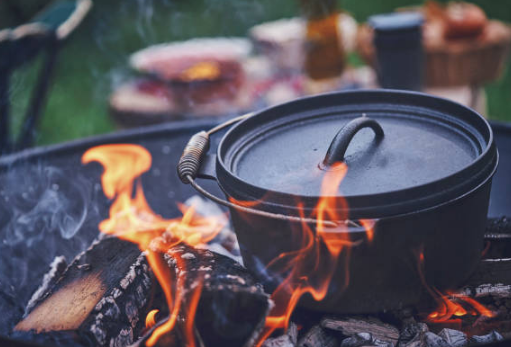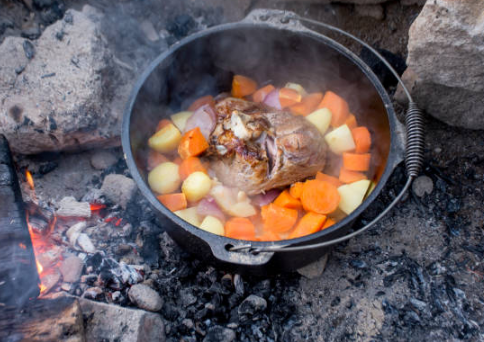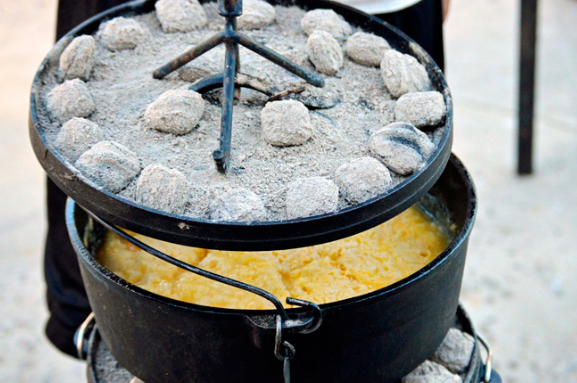If you feel the need to add to your ever-growing stock of camping gear, then I highly recommend buying a Dutch oven next time.
We’ve been thinking about buying one for over a year with the excuse that “it’s too heavy” or “we don’t really have a place to store it” or “cooking with it seems too complicated”. Well, let me tell you, the camping menu before we camped in Holland quickly became inconsequential, and we were really skeptical about how we hadn’t had a camping holland oven for so long!

They’re not too heavy, cooking with them isn’t too complicated, and you’re sure to find a place to store them. So maybe it’s time to put aside the excuses and enjoy the meal with your campfire cooking.
What Is a Dutch Oven?
A Dutch roast is a large metal pot, usually a cast iron pan, that is used for cooking in an oven or stovetop, or in a more traditional way of cooking, enclosed with hot coals. The Dutch roast has a lid with a handle, and the outdoor type of Dutch roast has three legs in order to keep the coals underneath.
How to Choose a Dutch Oven for Camping
Whether you’re buying a brand new or used camping Dutch oven, make sure of the following:
- It has legs – preferably no less than three!
- There is a nice sturdy handle on the lid
- The lid fits perfectly
- The overall thickness of the metal is consistent
- The thin metal handle that comes with the oven itself, called the lifting ring, is sturdy enough and easy to move
You should also consider the size of the Dutch roast and whether you’re most likely feeding an army or just a comfortable meal for two.
Why Are Dutch Ovens Great for Cooking While Camping?
- Dutch ovens are versatile
- You can use them to bake, grill, boil, pan-fry, and stew
- You can put everything in a Dutch griddle, let it sit for a few hours, and dinner is ready!
- The taste of food cooked in a Dutch oven is unparalleled, and it has a depth to it – the food tastes like it was cooked over a campfire, but without the flavor of the campfire itself (if you know what I mean?).
- Dutch ovens are very durable

Seasoning a Dutch Oven
The origins of the Dutch roast can be traced back to the early 18th century, when an advanced production system was developed in the Netherlands. Since then, there have been some major upgrades in the way Dutch roasts are produced, and many brands of Dutch roasts are now seasoned before leaving the factory. However, if the Dutch roast has not yet been seasoned, it is an essential preparation and the easiest preparation to do before you head out into the wild.
A well-seasoned Dutch roast will be easier to clean, have non-stick properties, and will add a delicious smoky flavor to your dishes.
The newly bought Dutch roast pan has a protective coating that needs to be removed. Just scrub well with water, soap and steel wool. Dry with a towel and prepare to taste.
Here’s a quick guide to seasoning a Dutch roast at home:
- Preheat the electric/gas oven in the kitchen to 350°F
- Open windows and turn off smoke alarms
- Place the Dutch pot in the kitchen oven with the lid and heat it until it is almost unprocessable
- Remove from oven and use a paper towel to spread a thin layer of cooking oil over the entire pan, including the lid and legs
- Return the pan and lid to the top layer of the oven
- Place a baking sheet on the rack below to catch the dripping oil
- Bake the Dutch pan for one hour
- Turn off the oven and let the pot and lid cool in the oven
- Repeat the entire process
- Finally, remove from the oven and wipe with a clean, dry cloth when it has cooled
Cooking with a Dutch oven
To cook in a Dutch oven, you’ll need to be prepared (yes, I’m afraid you’ll need some gear). Your newly upgraded camping kitchen will need:
- Dutch roast pot
- A bag of coals or briquettes
- A pair of long pliers – used to move and place coal
- Lid lifter
- A pair of heat-resistant gloves
- A small broom – used to sweep the ashes off the lid before opening the lid
Step 1: Light the charcoal
Use a fire pit or barbecue/grill to light charcoal or briquettes and nurture them like a barbecue.
Step 2: Place the food in the pot
When the charcoal fire is ready, place the ingredients in the pot and cover the pot.

Step 3: Sort out the coal
Use tongs to place coals on the lid and under the pot. But not just put. There’s a scientific basis for this: use two coals per inch of oven diameter, three more on top and three less on the bottom.
For example:
- Pot size = 12 inches
- Total Coal = 24
- Number of briquettes below = 9 (12 lumps – 3)
- Number of top coals = 15 (12 coals + 3 coals)
This maintains a stable temperature of 325 – 350ºF, and you can even adjust the temperature: the general rule is two pieces of coal = 25°F.
Step 4: Place the food in a Dutch pot and cook
It’s tempting to lift the lid and check the progress of the camping cooking. But it’s best to let the oven work its magic and only sneak a peek when you start smelling something that’s about to enter your hungry stomach! If you really can’t help it, you can use a lid lifter to look inside, but be very careful not to let the ashes fall into the food.
Step 5: Sweep away the ashes
Now that the cry of “dinner is ready” has been made, the coals are taken down with tongs and any ash is brushed off the lid. This way that when you open the lid, the ashes don’t get into the food.
Tips
- Do not use plastic or silicone cookware
- Never pour cold water into a hot Dutch pan – it may break
- Scrub clean with a wire brush or steel wool
- Use a strong cleanser – it will remove the seasonings
- Leave water in it – it will rust

